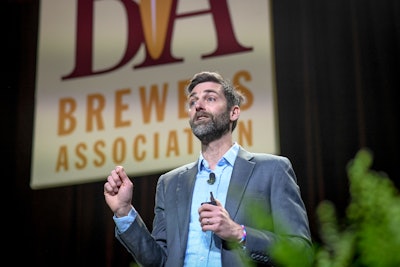
At the 2024 Craft Brewers Conference, Bart Watson, Chief Economist for the Brewers Association, gave his annual report on the state of the craft brewer industry. It came at no surprise that the overarching results showed the industry is at a standstill, with craft production measured at -1% in 2023.
While not experiencing significant growth, craft beers are far from going extinct. The hardest year in modern craft brew history was 2020 with production at -10% due to the effects of social distancing during the height of the COVID-19 pandemic.
Watson laid out the landscape for why 2023 ended up being such a competitive and challenging year. It’s true that one source of competition for the industry is manifest in couches and smart devices—a culture among society that may have some roots in the working-, eating-, and living-from-home aspects of 2020. But Watson breaks it down to three core challenges.
Demand
 Watson says the era of rapid adoption has come to an end.
Watson says the era of rapid adoption has come to an end.
“For years, we were in an era of rapid adoption, that kind of classic ‘S’ curve growth, where new drinkers were coming into the category. They were discovering your amazing beers. And they were also increasing craft as a percentage of their occasions,” said Watson.
But like all “‘S’ curves,” eventually that demand slows or starts to decrease, reaching the natural limits of that era. A 10-to-one opening-to-closing ratio of craft brew businesses permeated from 2014 to 2016. Since 2022, there have been approximately 1200 openings and 900 closings. Watson admits that so far in 2024, the Brewers Association tracks more closings than openings.
Another way to put it is that between 2012 and 2019 the number of craft breweries was growing and compounding annually at 3.5% rate. Since 2019 drinkers have decreased to a compounding 1.6% rate.
Watson explained that there are two ways to increase demand, 1) through the number of drinkers and 2) through the percentage of occasions they dedicate to the category of craft beer. The Brewers Association data shows that more people are moving out of the category than are stepping in.
 With demand decreasing each year, craft brewers need to find new ways to attract and retain drinkers.
With demand decreasing each year, craft brewers need to find new ways to attract and retain drinkers.
 The gap between openings and closings is indicative of the difficulty in keeping craft brew businesses open, but Watson says there are reasons for optimism.
The gap between openings and closings is indicative of the difficulty in keeping craft brew businesses open, but Watson says there are reasons for optimism.
Competition
The second challenge discussed by Watson was competition, both within craft and across the entire alcoholic beverage industry. To measure this challenge within craft, the Brewers Association measured the production capacity ratio of craft breweries, which has dropped to its lowest level at 51% since being an added data point. This means that, collectively, the capacity of craft is only half used, which has led brewers to supplement with other parts of the beverage industry to fill that excess capacity. More than 600 active breweries now have distilled spirit permits, according to research by the Brewers Association.
 Competition within craft beer as well as among alcoholic beverages is increasing.
Competition within craft beer as well as among alcoholic beverages is increasing.
Beyond the craft supply, research also shows an increase in the number of TTB (Alcohol and Tobacco Tax and Trade Bureau) permits for breweries, wineries, and distilled spirits. Currently there are more than 37,000 active TTB permits across these categories, which Watson estimated at about one permit per 4,021 American drinkers. This results in competition for the drinker, retailers, and distributors as well.
“Just making good local beer may no longer be enough. You have to do more to stand out. And that often comes down to business decisions,” said Watson.
The business environment
The third challenge listed by Watson is the overall business environment. Cost for just about everything a craft brewer needs to make beer has increased in recent years. Considering that craft brewers cannot pass on the price increase to the customer due to the lack in demand, this challenge has a significant impact.
Watson pointed out that the entire beverage alcohol industry is experiencing this same challenge. He speculated that a contributing factor may be the growing international demonization of alcohol from public health and anti-alcohol activists seeking stricter rules and regulations. Such views may be impacting Americans’ perception as well.
 Watson suspects the growing international demonization of alcohol may be impacting American drinkers.
Watson suspects the growing international demonization of alcohol may be impacting American drinkers.
However, Watson said the bigger contributor is the state of the alcoholic beverage market.
“The basic point here is it's a crowded marketplace. And it's harder to get your products out on the market than it was before with so many options,” he said, but emphasized, “It's worth remembering that customers are still willing to pull out their wallets and spend money on beers and brands that they value.”
Customers are reported to have spent nearly $30 billion on beer from small and independent brewers in 2023. And according to a Brewers Association survey, though 54% of breweries reported they were down in sales in 2023, 44% reported they were up. That 44% represents thousands of craft brewers who found ways to grow despite the challenges facing the industry.
Breaking down brew by category
The needs and approach to growth strategies will vary by category within craft, namely taproom, brewpub, contract, regional and microbrewery.
Taprooms are the most numerous business model in the country, and though they were historically able to find growth amidst very challenging years, they were down 2% this last year. Taprooms still have the most openings and outnumber closings at a 2-to-1 ratio. Further, 47% of taproom businesses in the survey said they grew. However, that number is down from 51% in the 2022 survey. Among the taprooms that grew, the data showed that those with a higher distribution percentage grew faster than those with a lower percentage.
 | Standing Out with Sustainable Strategies in Craft Beer and Spirits |
Brewpubs experienced a 4% decrease and faced not only the challenges in the craft brew industry, but those of the restaurant industry as well—such as order-to-go and delivery.
“Getting people out is just harder than it has been in the past and brewpubs are hyper aware of this,” said Watson. “They're thinking about their hospitality concept, about what differentiates them. And they're thinking about how it gets people off their couches and to actually walk through their doors.”
Brewpubs have needed to focus more on the food side of their business and, contrary to taprooms, have grown more onsite than through distribution.
The contract brewer business is up and coming. Its growth stayed roughly the same but is expected to increase in this era of excess capacity. Regionals, on the other hand, experienced a 1% growth thanks to its top players and also saw a trend between a high onsite percentage and increased growth, though onsite makes up only 2% of regional volume. Microbreweries had the most challenging year at -5%.
“Talking to microbreweries, you could feel them getting squeezed in between the smallest local players, and regional and national players with more scale of influence and distribution,” said Watson.
Microbreweries need to strongly consider geography and where they are going with which partners. They must think critically about distributors, the markets to enter, and the markets to leave that are no longer relevant to their brand, according to Watson.
Growth strategies for the future
 Innovation will be the key to future growth.
Innovation will be the key to future growth.
“Keep thinking about innovation and how you build those strong brands in this competitive environment. Innovation is what started that first ‘S’ curve. And innovation is what's going to get us back to first incremental growth, and hopefully later, to broader and deeper category growth,” said Watson.
Innovation goes beyond the beer itself to how the customer thinks about the product, according to Watson. Even if the beer stays the same but the drinker thinks about it in a different way, that success can encourage them to step into the category. Watson says that shifting a mere 1% or 2% into the category while maintaining existing customers will have a strong impact on the growth of the industry.
Watson concluded with three main reasons to believe that the craft brew category can once again experience an era of rapid adoption and growth. First, craft can weather challenges and come out relatively unscathed. Despite challenges, craft has retained roughly similar volumes for the last five years. Though the category may struggle, it will not collapse.
Second, many of craft’s customer base is fiercely loyal and supports the beer and its promotional merchandise. Watson cautioned to not take this for granted however and find ways to reel in the younger generations so that they too become loyal customers.
Third, breweries are vastly different one from the other, from size to business model to the beer and how it’s marketed and branded. This variation is a strength if each craft brewer leans into it. During the era of rapid growth, it made sense to stick to what was working with the industrial chic warehouse taproom that people had come to expect. This approach will not work collectively anymore.
“Learn from your community and apply what you learn to your business. Be sure to think about how you can tailor those [lessons] to your company, to your brand, to what you stand for,” said Watson. “[Use] your authentic voice and apply it to your craft beer, offering something different in the marketplace—beers and products and brands that people haven't seen before. I think our path to returning back to growth is finding more of that again.”
 | E-Commerce Challenges and Opportunities for Craft Beer and Spirits Producers |



















